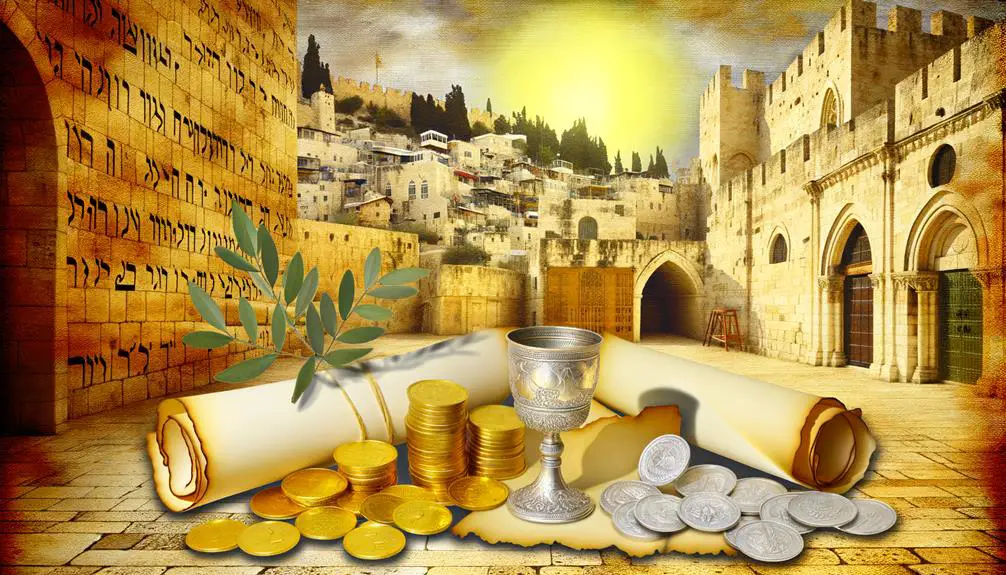Uncover the deep symbolism of silver and gold in the Bible, revealing lessons on purity, greed, and divine providence that still resonate today.

Silver and Gold in the Bible
All that glitters isn't gold, but in the Bible, both silver and gold sparkle with profound symbolic meanings. You'll find these metals not only underscore tales of faith and judgment but also weave through lessons on greed, purity, redemption, and divine providence.
The historical and cultural backdrop against which these stories unfold adds layers of depth to their understanding. As you explore these narratives, you'll uncover how silver and gold served as more than mere currency; they were pivotal in teaching lessons that resonate through the ages.
Let's embark on this journey to unravel the rich symbolism and timeless messages these precious metals hold.
Key Takeaways
- Silver and gold symbolize spiritual purity and divine promises in biblical narratives.
- These metals transcend their material worth, embodying faith, devotion, and divine truths.
- Biblical stories use silver and gold to teach lessons on greed, purity, and redemption.
- Beyond economic value, they represent God's providence and the spiritual wealth of His covenant.
Symbolic Meanings Explored

Silver and gold, beyond their earthly value, embody profound symbolic meanings in the Bible, reflecting divine principles and human experiences. These metals, in their shimmering essence, are more than mere materials; they're imbued with rich, multifaceted symbolism, deeply intertwined with the spiritual narrative of humanity's relationship with the divine.
Metallic purity, a key attribute of both silver and gold, serves as a metaphor for spiritual refinement and purity. Just as these metals undergo a process of refinement to rid themselves of impurities, so too are you called to purify yourself, shedding imperfections to mirror the holiness and perfection of the divine. This allegory resonates through biblical texts, where the purification processes of silver and gold are likened to the spiritual purification of believers, highlighting a path towards divine closeness and moral integrity.
Moreover, silver and gold act as covenant symbols within the biblical narrative, representing the permanence and unbreakable nature of the bond between the divine and humanity. Gold, with its incorruptible nature, often symbolizes divinity, eternal strength, and the unfading promise of God's presence. Silver, reflective and bright, is frequently associated with redemption, grace, and the price of atonement. These metals, therefore, aren't merely elements but are deeply emblematic of the enduring, unyielding covenant between God and His people.
Through their symbolic richness, silver and gold in the Bible transcend their material worth, offering you insights into divine truths. They remind you of the journey towards spiritual purity and the everlasting nature of divine promises, encapsulating the essence of faith and devotion.
Historical and Cultural Context

Understanding the historical and cultural context of silver and gold in biblical times enriches your appreciation of their symbolic significance, revealing how deeply these metals are intertwined with ancient practices and beliefs. You'll find that these precious metals weren't only the backbone of trade practices but also central to artistic expressions that communicated wealth, purity, and divine favor.
In the bustling markets of the ancient Near East, silver and gold served as the standard for trade and commerce. These metals facilitated trade across vast distances, connecting civilizations through a common medium of exchange. This wasn't merely an economic activity; it was a display of trust and mutual respect among traders and nations. You'd witness the careful weighing of silver and gold, ensuring fairness in transactions that often bridged cultural divides.
Beyond the marketplaces, silver and gold were masterfully crafted into objects of beauty and religious significance. Artisans poured their skill into creating items that adorned temples, signaled status, and were offered as sacrifices. These artistic expressions were a tangible manifestation of the society's values and its reverence for the divine. Through intricately designed vessels, jewelry, and religious artifacts, you can catch a glimpse of how these metals were imbued with symbolic meanings that transcended their material worth.
As you delve into this historical and cultural backdrop, you're invited to see beyond the physical properties of silver and gold. You're encouraged to ponder their role in shaping human interactions, artistic endeavors, and spiritual practices. This perspective deepens your understanding of their significance within the biblical narrative, illuminating the rich tapestry of faith, culture, and human history interwoven with these timeless metals.
Stories of Faith and Judgement

Frequently, the Bible intertwines tales of faith and judgment with the symbolic use of silver and gold, inviting you to explore deeper layers of meaning in these narratives. These precious metals aren't merely decorative or of material value; they're imbued with spiritual significance, serving as miraculous provisions and covenant symbols that highlight moments of divine intervention and moral testing.
Consider these three pivotal stories:
- The Golden Calf (Exodus 32): Here, gold becomes a symbol of idolatry and apostasy. The Israelites, in Moses' absence, fashion a golden calf for worship. This act of faithlessness against God's covenant brings severe judgment upon them, yet it also sets the stage for Moses' intercession and God's merciful forgiveness. Gold, in this narrative, underscores the tension between faith and betrayal, serving as a stark reminder of the consequences of forsaking divine covenants.
- Solomon's Temple (1 Kings 6): Solomon's use of gold to adorn the temple signifies God's glory and the Israelites' reverence. The temple, rich in gold, stands as a testament to God's promise to dwell among His people, serving as a covenant symbol of divine presence and favor. This story celebrates the faithfulness of God's people and God's reciprocal faithfulness to them.
- The Gifts of the Magi (Matthew 2:11): Gold, presented to Jesus by the Magi, symbolizes His kingship. This gift, alongside frankincense and myrrh, foretells Jesus' divine authority and sacrificial death. The offering of gold to the newborn King illustrates the recognition of Jesus' sovereignty and serves as a miraculous provision for His family's imminent flight to Egypt.
These stories, rich in symbolism, encourage you to reflect on the profound spiritual truths they convey, revealing how faith and judgment are intricately woven with the divine purpose behind silver and gold.
Lessons on Greed and Purity

In the biblical narrative, lessons on greed and purity are intricately entwined with the use of silver and gold, urging you to contemplate the profound consequences of your desires and actions. These precious metals, symbols of immense wealth and divine craftsmanship, also serve as a mirror reflecting the human heart's inclination towards either purity or corruption. The stories you encounter, from the betrayal of Judas to the admonishments of the prophets, aren't just ancient tales but profound lessons that resonate with timeless relevance.
As you delve deeper, you'll see how the Bible doesn't shy away from exposing the harsh realities of wealth disparity and moral corruption. It's a cautionary tale that wealth, when pursued with avarice, leads to a spiritual void where the soul's purity is compromised for temporal gains. You're reminded that the pursuit of silver and gold can easily become an idol, replacing the divine with the material, and leading to a path of moral decay.
This narrative encourages you to reflect on your intentions and the impact of your pursuit of wealth on your spiritual well-being and on those around you. It's a call to examine your heart, to ensure that your actions align with a pursuit of purity rather than greed. The Bible's discourse on silver and gold, therefore, isn't just about the physical metals but about the choices you make and their reflection on your soul's purity or corruption.
In essence, these lessons serve as a guide to navigate the complexities of wealth and morality, urging you to choose a path that fosters spiritual purity over material gain, and to be mindful of the corrosive nature of greed on your moral compass.
Redemption and Divine Providence

Beyond the allure of silver and gold, the Bible vividly illustrates how redemption and divine providence offer a wealth that material riches can't rival. This spiritual wealth, underpinned by faith, trust, and obedience, surpasses the fleeting stability that economic resources promise.
- Economic Stability vs. Divine Providence: While silver and gold can purchase goods and influence, they can't buy peace, purpose, or eternal salvation. The Bible teaches that divine providence—God's guiding hand—ensures your needs are met, not through amassed wealth but through faith and reliance on Him. This divine care fosters a sense of security that no amount of silver or gold could.
- Redemption as the Ultimate Wealth: The concept of redemption in the Bible, particularly in the context of Jesus' sacrifice, is portrayed as the ultimate treasure. It's a gift that offers eternal life and reconciliation with God, a wealth that's immeasurable and incomparable to any earthly riches.
- Covenant Symbols: Silver and gold were often used in biblical times as symbols of covenants and promises. However, the true covenant lies in the promise of salvation and the provision of divine guidance. These are the real covenant symbols that signify a relationship with the divine, offering a stability far beyond what any economic system can provide.
In essence, the Bible positions redemption and divine providence as the true treasures, far surpassing the value of silver and gold. They represent a divine wealth that ensures not just an earthly stability but an eternal one, rooted in spiritual fulfillment and divine promise.
Frequently Asked Questions
How Does the Modern-Day Value and Usage of Silver and Gold Compare to Their Roles and Significances Mentioned in the Bible?
Today, you'll find silver and gold's value and usage have evolved far beyond their historical roles. These metals are now pivotal in investment strategies, offering a hedge against inflation and market volatility.
Additionally, they've become staples in jewelry fashion, symbolizing wealth and style. While their biblical significance as symbols of wealth and offerings remains revered, their modern applications demonstrate a dynamic versatility that transcends mere monetary or decorative value.
Are There Any Environmental Impacts Associated With the Mining and Use of Silver and Gold That Contrast With Biblical Views on Stewardship of the Earth?
You're facing a dilemma where modern mining techniques for silver and gold, essential for today's economy, often clash with the biblical principle of earth stewardship.
While the Bible advocates for caring for creation, current practices can lead to significant environmental impacts.
However, initiatives like ecological rehabilitation strive to bridge this gap, aiming to restore damaged ecosystems.
This approach reflects a reverence for nature, aligning with the stewardship values found in biblical teachings.
How Have Interpretations of Silver and Gold's Symbolism in the Bible Changed Over Time Across Different Christian Denominations?
You're delving into how interpretations of silver and gold's symbolism have evolved, noting shifts due to historical authenticity and cultural influence. Different Christian denominations have uniquely framed these elements, reflecting varied theological perspectives.
Over time, insights from archeology and historical scholarship have enriched understanding, while cultural contexts have shaped symbolic meanings. This journey through changing interpretations not only honors the depth of these symbols but also celebrates the diversity within Christian thought.
Can You Provide Examples of How Silver and Gold Are Used in Contemporary Religious Ceremonies or Artifacts, Drawing on Their Biblical Significance?
You're exploring how silver and gold weave through contemporary religious practices, beyond their historical roots.
Religious jewelry often carries these metals, symbolizing purity and divinity, directly linking wearers to their faith.
In sacred architecture, silver and gold accentuate spaces with an aura of sanctity, from altarpieces to domes.
These materials, rich in biblical symbolism, continue to embody spiritual ideals, enriching ceremonies and artifacts with deeper, revered meanings.
How Do Non-Christian Religions and Cultures View the Biblical Narratives and Symbolism of Silver and Gold, and Do They Find Parallels Within Their Own Traditions?
You might find it fascinating how Hindu rituals and Islamic finance, among other non-Christian traditions, draw parallels to the symbolism of silver and gold.
In Hinduism, these metals are integral in rituals, symbolizing purity and prosperity. Meanwhile, Islamic finance respects gold as a stable financial standard, echoing biblical reverence.
These parallels showcase a universal appreciation for silver and gold's intrinsic values, transcending religious boundaries with their shared symbolism.
Conclusion
In the grand tapestry of biblical narratives, silver and gold aren't just elements; they're threads that weave through tales of human nature, illuminating our flaws and virtues. Like a mirror reflecting the divine, they reveal lessons on greed, purity, and redemption.
Your journey through these stories is a pilgrimage towards understanding the intricate balance between material wealth and spiritual richness. In this light, silver and gold transcend their earthly value, becoming symbols of a higher, divine providence and human redemption.



Sign up